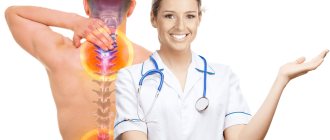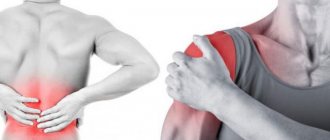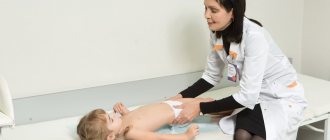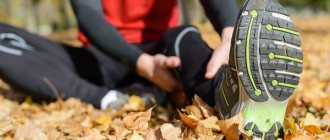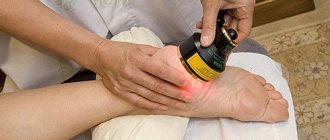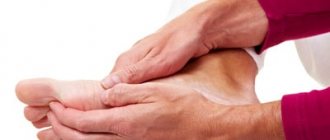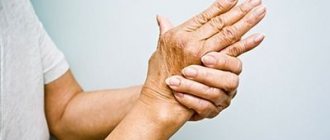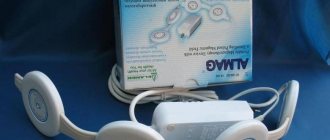Osteoarthrosis (from the Greek arthron - joint, synonyms: deforming arthrosis, deforming osteoarthritis) is a polyetiological degenerative-dystrophic disease of the joints, characterized by changes in the articular surfaces, the proliferation of marginal osteophytes, leading to deformation of the joints. The basis of the disease is a malnutrition of the articular (epiphyseal) ends of the bones.
Osteoarthritis is one of the most ancient human diseases, which is the evolutionary heritage of man. Osteoarthritis usually affects middle-aged and elderly people with excess body weight. According to statistics, it affects more than 10% of the surveyed population of the planet of all ages; after 80 years, this disease occurs in almost everyone.
The disease is progressive. At the beginning, painful changes appear in the inner (so-called synovial) membrane of the joint capsule, then they capture the cartilage covering the articular surfaces of the articulating bones; the cartilage gradually breaks down, exposing the bone; The bone tissue is thinned out in places, thickened in places, bone spike-like outgrowths are formed - a picture of deforming arthrosis develops.
Causes of the disease:
- hereditary and congenital diseases of the osteoarticular system - congenital dysplasia of the hip joint, scoliosis, lordosis, kyphosis, flat feet, skeletal development abnormalities, flat feet (in which there is a shift in the center of gravity, leading to increased load on the joints);
- joint injuries;
- intra-articular fractures and dislocations;
— infections;
- old age (more often in the elderly and postmenopausal women);
- excessive stress on the joints (hard physical labor, excessive sports, excess body weight);
— chronic hemarthrosis (hemorrhage in the knee joint associated with a tear of the synovial membrane due to injury);
— diseases of the endocrine and nervous system (diabetes mellitus and neurotrophic arthropathy);
- vascular diseases of the lower extremities.
Due to severe pain and a sharp limitation in range of motion, osteoarthritis leads to loss of ability to work and disability, which has an important social significance.
Contraindications for laser use
Before using a laser on the knee joints, you need to take into account contraindications, which may include both somatic pathologies and general inflammatory processes occurring in the patient’s body.
The main contraindications for the use of laser treatment of knee joints are:
- tumors of the knee joints, benign and malignant;
- polio, tuberculosis and other serious infections of joint tissues;
- general infection of the body;
- acute respiratory and viral diseases accompanied by high body temperature;
- dystrophy of the muscle tissue surrounding the knee;
- intolerance (usually individual) to infrared radiation;
- ongoing chemotherapy.
The presence of contraindications for laser treatment of the knee joint can only be determined by an experienced doctor. Therefore, before starting a course of therapy, the orthopedist carefully studies all the patient’s medical documentation and the results of the examinations performed. An examination and medical history is taken. Potential causes of osteoarthritis and other pathologies of the knee joint are eliminated. And only after this the doctor begins to develop an individual course of therapy.
Symptoms:
- Aching pain in the joint, aggravated by movement and stress on the affected joint. The pain usually gets worse towards the end of the day.
- Swelling appears only during exacerbations, is quite noticeable and causes great inconvenience.
— Aching and crunching in the joint, and at first the crunching is not strong, but without treatment, the crunching gets stronger and is even audible to others. Crunching in the joints is explained by the fact that gas bubbles located in the synovial fluid begin to burst when the joint capsule is stretched, thus a cracking or crunching sound is heard. Crunching in the joint is the first of the early symptoms of osteoarthritis.
- Stiffness - restriction of joint mobility. The patient has difficulty flexing and straightening the joint.
More often, arthrosis develops in the hip, knee and metatarsal-phalangeal joints. Moreover, gonarthrosis (arthrosis of the knee joints) is more common in women, while coxarthrosis (arthrosis of the hip joints) is more common in men.
For gonarthrosis _
pain in the knee is localized on the front or inner lateral surface of the joint, significantly increases when walking and decreases at rest, the joint is swollen, movements in the knee are limited. Small, dense, painful nodules form in the muscles located near the knee joint.
Coxarthrosis is the most common pathology among joint diseases in humans. The main causes of this disease are the violation or absence of straight posture, the habit of sitting with legs crossed, leaning on one arm, sitting at an angle to the table and sleeping, turning at the hip on the bed. The main symptom of coxarthrosis is pain in the groin, radiating down the front and side of the thigh, sometimes to the buttock or knee. At rest, the pain subsides, but when you try to get out of a chair or bed, it intensifies. It is difficult for a person suffering from coxarthrosis to move his leg to the side, it is difficult to pull his leg to his chest, it is difficult to put on socks and shoes, he is unlikely to be able to sit on a chair “astride”, spreading his legs wide apart, or will do it with great difficulty. The leg almost stops rotating (from the hip) to the right and left or rotates due to movements of the lower back.
Treatment
Treatment is individual and is prescribed only after an accurate diagnosis has been made. The goals of the treatment are: reducing the severity of pain; optimization and maintenance of the functional state of joints; preventing or slowing the progression of structural changes in articular tissues of cartilage, subchondral bone, ligaments and muscles; informing patients about the course, treatment methods and outcomes of the disease.
The treatment method for a particular patient should be developed taking into account the severity and extent of articular damage, the general status of the patient and the presence of concomitant diseases. This is achieved by both medicinal and non-medicinal methods, if ineffective they resort to surgical methods of treatment.
In the initial stage of osteoarthritis, you can cope with the help of drug therapy, which allows you to stop further destruction of cartilage and restore its structure, eliminate or reduce pain, and restore motor functions of the joint. For this purpose the following are used:
- painkillers , non-steroidal anti-inflammatory drugs (NSAIDs);
- hormonal drugs (adrenocorticotropic), which are especially effective when administered into the affected joint;
— inhibitors of proteolytic enzymes, biogenic stimulants;
- chondroprotectors - drugs that normalize the secretion of joint fluid, restore articular cartilage or prevent its destruction (destruction). This group of drugs is effective only in grades I-III. osteoarthritis, since completely destroyed cartilage cannot be restored;
- implants - preparations based on hyaluronic acid, an actual analogue of synovial fluid in joints;
— homeopathic, extractive, vascular, metabolic and vitamin preparations, etc..
Drug therapy does not always lead to the desired result; its effect is sometimes short-lived; moreover, almost all drugs have undesirable side effects.
are successfully used for osteoarthritis . Moreover, physiotherapy often becomes the leading treatment method, an alternative to drug therapy. For osteoarthritis, local physiotherapy is prescribed: laser therapy, laser treatment, magnetic therapy, electrotherapy, phototherapy, heat and cryotherapy, mechanical treatment, etc.
Indications for the use of physiotherapy are based on the fact that physiotherapeutic procedures improve peripheral, regional and central blood circulation, have an analgesic effect, improve tissue trophism, normalize neurohumoral regulation and impaired immune processes. Radon, sodium chloride, iodine-bromine, hydrogen sulfide baths are used, mud therapy, paraffin, ozokerite applications, massage, and physical therapy are widely used.
Physical therapy (physical therapy) should be regular and carried out without increasing the load on the articular surface, thereby helping to strengthen the muscles. Exercises recommended by your doctor for osteoarthritis should be performed while sitting or lying down. Kinesiotherapy (in translation - “treatment with movement”) is a type of physical therapy that has a positive effect on joints, muscles and ligaments.
Massage – has an analgesic, anti-inflammatory effect, helps restore joint function, reduce tension, improves trophism, tone and strength.
Diet – There is no specific diet for osteoarthritis. The diet should be sufficiently varied, fortified, and balanced. Do not overeat, reduce your weight if you are overweight, thereby reducing the load on the joint.
Let us consider in more detail the issue of using quantum therapy methods for osteoarthritis.
Laser therapy is a modern, highly effective method of treating a wide range of diseases, including osteoarthritis.
The method is based on the use of small doses of several electromagnetic and light radiations at once:
— pulsed infrared laser radiation;
— pulsed incoherent infrared radiation;
- pulsating red and blue light;
— constant magnetic field;
— transcutaneous electrical neurostimulation.
Laser therapy for osteoarthritis includes:
1. Laser hemotherapy (general effect on the body’s metabolic processes, increased blood flow in the problem area):
2. Zonal effect on joints:
3. Laser photophoresis (LPP):
Laser photophoresis is the simultaneous use of laser therapy and a drug (gel, cream, mud, etc.), resulting in increased tissue permeability for the drug to enter the problem area, improved blood circulation, relief of pain, muscle spasm, decreased swelling, inflammation, metabolic processes in joint tissues improve.
This technique has proven to be highly effective in the treatment of arthrosis. The procedure is safe, comfortable, painless and easy to perform.
Indications for use
Laser treatment is used for acute and chronic joint diseases of inflammatory and degenerative origin.
Laser therapy is recommended for:
- periarthritis;
- periarthritis complicated by bursitis;
- arthrosis;
- arthritis;
- osteochondrosis;
- Bekhterev's disease;
- disorders of trophic functions in the limbs;
- heel spurs;
- inflammation of the thigh tendons;
- long-term non-healing wounds;
- pain after injuries and amputations of limbs;
- pathological conditions caused by failures in the neurotrophic control system.
Laser therapy for arthrosis is effective and completely safe for patients, but it can only be done on the recommendation of a doctor.
Methodology for laser photophoresis
1. First, apply a thin layer of the medicinal substance to clean, dry skin.
It can be a cream, therapeutic mud, gel with an analgesic, anti-inflammatory, chondroprotective effect. 2. Attachment No. 4 from the set of optical attachments KON-1 is screwed onto the emitter of the RIKTA series device. 3. The session is carried out at a frequency of 1000 Hz, the exposure time for one joint is 3-5-10 minutes. The session time depends on the size of the joint:
Small - 3 minutes, medium - 5 minutes, large - 10 minutes.
Method of influence: contact scanning, emitter movement speed 0.5-1.5 cm per second.
The course of treatment consists of 10-12 sessions, 1 session per day or every other day.
At the end of your laser therapy session, take a 15-minute rest.
With a sluggish process, it is recommended to carry out treatment in the first half of the day, up to 12 hours, with an active process - in the afternoon. These recommendations are related to the chronobiological processes of the human body.
The use of quantum photophoresis with painkillers and chondroprotective drugs is especially effective in cases of severe pain.
Patients note that after the first sessions of laser therapy, pain in the joint disappears, swelling of the surrounding tissues sharply decreases, inflammatory manifestations decrease, tension and spasm of the muscles around the affected joint are relieved.
After a course of laser therapy, patients note a surge of strength, the ability to move independently, painlessly, posture improves, and further joint deformation is prevented.
In the initial stages of the disease, laser therapy allows you to completely get rid of osteoarthritis, and in advanced cases, it can significantly improve the situation and ensure stable remission.
Along with the above treatment, patients with osteoarthritis are recommended to undergo sanatorium-resort treatment in areas with relatively low air humidity, without frequent weather changes and cyclones - the southern coast of Crimea, the North Caucasus, the Urals, Central Asia.
In severe or advanced cases, if there is no effect from the treatment measures, a surgical operation (endoprosthetics) to replace the joint with an artificial one - a metal implant that replaces the articular surfaces. After the recovery period, the person almost completely returns to a full life. Thanks to modern technologies, endoprostheses last a long time - 20-30 years.
Flaws
Cold laser therapy has several disadvantages.
Patients usually do not notice complete disappearance of pain after the first procedures. As a rule, from 8 to 30 procedures are necessary, depending on the severity and duration of the disease.
Patients have to go to the doctor quite often for procedures, at least 2 to 4 times a week. It is possible for chronic problems to worsen for a few days after treatment, but for most patients these flare-ups are short-term.
Prevention
Prevention of osteoarthritis is divided into primary and secondary.
Primary prevention should begin in childhood and consist of monitoring children’s posture, correct posture at a desk to avoid the development of scoliosis, correcting flat feet, maintaining normal weight (in accordance with age and height), and proper organization of physical activity on a growing body.
Secondary prevention consists of following the recommendations of specialists on physical activity and the use of basic and preventive treatment. Secondary prevention measures consist of timely detection of persons suffering from minimal signs of incipient osteoarthritis, compliance with measures that prevent the recurrence of reactive synovitis - measured walking, light work, walking with support and other activities that unload the joints, as well as the constant use of basic therapy for osteoarthritis and general strengthening measures , leading to improved general blood circulation and improved metabolism.
Laser therapy methods
“Doctors are hiding the truth!”
Even “advanced” joint problems can be cured at home! Just remember to apply this once a day...
Three methods of laser treatment of pathologies:
| Method name | Principle of procedure | Main results |
| Contact compression treatment | The laser conductor will be pressed against the affected area | Relieving swelling, pain, inflammation |
| Contact method | Light touch of LEDs to the inflamed area | Improving blood circulation, relieving pain |
| Remote influence method | The beam will affect the human body at a certain distance | Tissue repair |
The choice of a specific method for laser therapy is always selected by the attending physician for each patient individually. The specialist must take into account the etiology of the person’s disease, its neglect, and the presence of complications.
